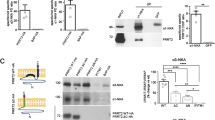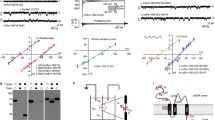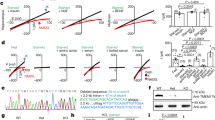Abstract
Hypertonia, which results from motor pathway defects in the central nervous system (CNS), is observed in numerous neurological conditions, including cerebral palsy, stroke, spinal cord injury, stiff-person syndrome, spastic paraplegia, dystonia and Parkinson disease. Mice with mutation in the hypertonic (hyrt) gene exhibit severe hypertonia as their primary symptom. Here we show that hyrt mutant mice have much lower levels of γ-aminobutyric acid type A (GABAA) receptors in their CNS, particularly the lower motor neurons, than do wild-type mice, indicating that the hypertonicity of the mutants is likely to be caused by deficits in GABA-mediated motor neuron inhibition. We cloned the responsible gene, trafficking protein, kinesin binding 1 (Trak1), and showed that its protein product interacts with GABAA receptors. Our data implicate Trak1 as a crucial regulator of GABAA receptor homeostasis and underscore the importance of hyrt mice as a model for studying the molecular etiology of hypertonia associated with human neurological diseases.
This is a preview of subscription content, access via your institution
Access options
Subscribe to this journal
Receive 12 print issues and online access
$209.00 per year
only $17.42 per issue
Buy this article
- Purchase on Springer Link
- Instant access to full article PDF
Prices may be subject to local taxes which are calculated during checkout






Similar content being viewed by others
References
Wziesendanger, M. Pathophysiology of Muscle Tone (Springer-Verlag, New York, 1972).
Lorish, T.R., Thorsteinsson, G. & Howard, F.M., Jr. Stiff-man syndrome updated. Mayo Clin. Proc. 64, 629–636 (1989).
Kopito, R.R. Aggresomes, inclusion bodies and protein aggregation. Trends Cell Biol. 10, 524–530 (2000).
Mayer, R.J., Lowe, J., Lennox, G., Doherty, F. & Landon, M. Intermediate filaments and ubiquitin: a new thread in the understanding of chronic neurodegenerative diseases. Prog. Clin. Biol. Res. 317, 809–818 (1989).
Colomer, V. et al. Huntingtin-associated protein 1 (HAP1) binds to a Trio-like polypeptide, with a rac1 guanine nucleotide exchange factor domain. Hum. Mol. Genet. 6, 1519–1525 (1997).
Li, Y., Chin, L.S., Levey, A.I. & Li, L. Huntingtin-associated protein 1 interacts with hepatocyte growth factor-regulated tyrosine kinase substrate and functions in endosomal trafficking. J. Biol. Chem. 277, 28212–28221 (2002).
Beck, M. et al. Identification, molecular cloning, and characterization of a novel GABAA receptor-associated protein, GRIF-1. J. Biol. Chem. 277, 30079–30090 (2002).
Marcora, E., Gowan, K. & Lee, J.E. Stimulation of NeuroD activity by huntingtin and huntingtin-associated proteins HAP1 and MLK2. Proc. Natl. Acad. Sci. USA 100, 9578–9583 (2003).
Kittler, J.T. et al. Huntingtin-associated protein 1 regulates inhibitory synaptic transmission by modulating {gamma}-aminobutyric acid type A receptor membrane trafficking. Proc. Natl. Acad. Sci. USA 101, 12736–12741 (2004).
Hadano, S. et al. Cloning and characterization of three novel genes, ALS2CR1, ALS2CR2, and ALS2CR3, in the juvenile amyotrophic lateral sclerosis (ALS2) critical region at chromosome 2q33-q34: candidate genes for ALS2. Genomics 71, 200–213 (2001).
Stowers, R.S., Megeath, L.J., Gorska-Andrzejak, J., Meinertzhagen, I.A. & Schwarz, T.L. Axonal transport of mitochondria to synapses depends on milton, a novel Drosophila protein. Neuron 36, 1063–1077 (2002).
Iyer, S.P., Akimoto, Y. & Hart, G.W. Identification and cloning of a novel family of coiled-coil domain proteins that interact with O-GlcNAc transferase. J. Biol. Chem. 278, 5399–5409 (2003).
McKernan, R.M. & Whiting, P.J. Which GABAA-receptor subtypes really occur in the brain? Trends Neurosci. 19, 139–143 (1996).
Kirsch, J., Wolters, I., Triller, A. & Betz, H. Gephyrin antisense oligonucleotides prevent glycine receptor clustering in spinal neurons. Nature 366, 745–748 (1993).
Essrich, C., Lorez, M., Benson, J.A., Fritschy, J.M. & Luscher, B. Postsynaptic clustering of major GABAA receptor subtypes requires the gamma 2 subunit and gephyrin. Nat. Neurosci. 1, 563–571 (1998).
Feng, G. et al. Dual requirement for gephyrin in glycine receptor clustering and molybdoenzyme activity. Science 282, 1321–1324 (1998).
Moss, S.J. & Smart, T.G. Constructing inhibitory synapses. Nat. Rev. Neurosci. 2, 240–250 (2001).
Barnes, E.M., Jr. Assembly and intracellular trafficking of GABAA receptors. Int. Rev. Neurobiol. 48, 1–29 (2001).
Kittler, J.T., McAinsh, K. & Moss, S.J. Mechanisms of GABAA receptor assembly and trafficking: implications for the modulation of inhibitory neurotransmission. Mol. Neurobiol. 26, 251–268 (2002).
Fritschy, J.M. & Brunig, I. Formation and plasticity of GABAergic synapses: physiological mechanisms and pathophysiological implications. Pharmacol. Ther. 98, 299–323 (2003).
Luscher, B. & Keller, C.A. Regulation of GABAA receptor trafficking, channel activity, and functional plasticity of inhibitory synapses. Pharmacol. Ther. 102, 195–221 (2004).
Bedford, F.K. et al. GABA(A) receptor cell surface number and subunit stability are regulated by the ubiquitin-like protein Plic-1. Nat. Neurosci. 4, 908–916 (2001).
Brickley, K., Smith, M.J., Beck, M. & Stephenson, F.A. GRIF-1 and OIP106, members of a novel gene family of coiled-coil domain proteins: association in vivo and in vitro with kinesin. J. Biol. Chem. 280, 14723–14732 (2005).
Gorska-Andrzejak, J. et al. Mitochondria are redistributed in Drosophila photoreceptors lacking milton, a kinesin-associated protein. J. Comp. Neurol. 463, 372–388 (2003).
Li, X.J. et al. A huntingtin-associated protein enriched in brain with implications for pathology. Nature 378, 398–402 (1995).
Block-Galarza, J. et al. Fast transport and retrograde movement of huntingtin and HAP 1 in axons. Neuroreport 8, 2247–2251 (1997).
Engelender, S. et al. Huntingtin-associated protein 1 (HAP1) interacts with the p150Glued subunit of dynactin. Hum. Mol. Genet. 6, 2205–2212 (1997).
Li, S.H., Gutekunst, C.A., Hersch, S.M. & Li, X.J. Interaction of huntingtin-associated protein with dynactin P150Glued. J. Neurosci. 18, 1261–1269 (1998).
Gauthier, L.R. et al. Huntingtin controls neurotrophic support and survival of neurons by enhancing BDNF vesicular transport along microtubules. Cell 118, 127–138 (2004).
Levy, L.M., Dalakas, M.C. & Floeter, M.K. The stiff-person syndrome: an autoimmune disorder affecting neurotransmission of gamma-aminobutyric acid. Ann. Intern. Med. 131, 522–530 (1999).
Acknowledgements
We thank J. Estes for initial discovery of the mutant; W.B. Dobyns, F. Elsen, G. Ghadge, H.A. Jinnah, U. Kang, O. Lazarov, K. Millen, B. Popko, J.M. Ramirez, R. Roos, K. Sharma, S. Sisodia and M. Utset for observations of mutant mice and insightful discussions; and J. Brainer, Y.M. Chen, E. Chettiath, A. Lindgren, H. Macdonald, L. Moran, S. Rokosik, R. Tai and R. Samples for technical assistance. This work was supported in part by a center grant from the National Institutes of Health's National Center for Research Resources (to M.T.D.) and a Searle Scholarship and Burroughs Wellcome Career Award (to B.T.L.).
Author information
Authors and Affiliations
Corresponding author
Ethics declarations
Competing interests
The authors declare no competing financial interests.
Supplementary information
Supplementary Fig. 1
cDNA sequence of mouse Trak1 (also known as KIAA1042). (PDF 16 kb)
Supplementary Table 1
Primer sequences. (PDF 9 kb)
Rights and permissions
About this article
Cite this article
Gilbert, S., Zhang, L., Forster, M. et al. Trak1 mutation disrupts GABAA receptor homeostasis in hypertonic mice. Nat Genet 38, 245–250 (2006). https://doi.org/10.1038/ng1715
Received:
Accepted:
Published:
Issue Date:
DOI: https://doi.org/10.1038/ng1715



